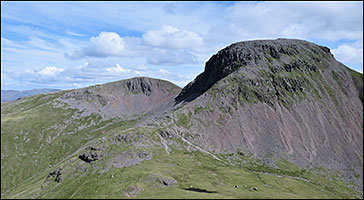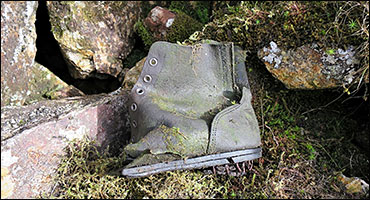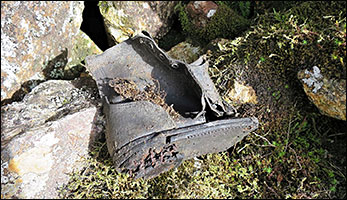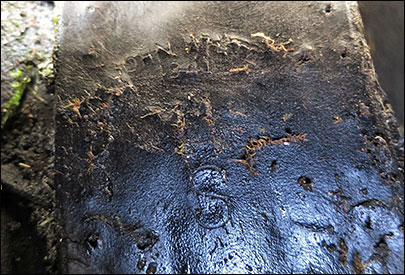|
|||||||||
| 2018 Copyright Lakeland Routes. Extracts from the story written by Richard Jennings. | |||||||||
|
John White Boot
|
|||||||||
|
|
|||||||||
| In October 2018 Richard jennings contacted us to ask about John White Boots. He had found a WWII air crash site and found a boot. This is part of his story added to a website: | |||||||||
|
While out walking with author and linescape artist Mark Richards, I decided to visit Stone Cove to search the area for any fragments left at the crash site. Stone Cove is a depression between Green Gable and Great Gable, and like the name suggests, it is littered with scree and boulders. Mark was in the process of “re-structuring” his eight volume ‘Lakeland Fellranger’ series and invited me to join him on one of his research days. The day was fantastic for the camera; the previous weeks were dull so I was keen to develop a new route for ‘Lakeland Routes’. Mark was walking the Ennerdale skyline which included Kirk Fell, Great Gable, Green Gable, Brandreth and Haystacks, however, I asked if he wouldn’t mind me diverting to Stone Cove while he scrambled over Great Gable; the plan then was to meet again on Green Gable.
Windy Gap is a narrow ridge (col) between Green Gable and Great Gable, and is a popular link for walkers wanting to climb these two Lakeland fells. From Moses’ Trod (a path that traverses below the two fells) a distinct scree path leads to Windy Gap, however, this route is less popular so I should be left undisturbed; not that I do get disturbed on the fells by the way, I just didn’t want anyone asking me what I was doing while bent over looking between the boulders. Oddly at this site I couldn’t find any fragments at the lower reaches of the cove; not a thing, only a couple of modern day objects like water bottles, a map case and a pair of underpants! However, when I arrived at the impact area, just below Windy Gap, I did find this crumpled piece of aluminium, and I was in no doubt that it came from an aircraft; I was well chuffed because I hadn’t seen any fragments reported on the internet. Just a few feet away, between two large boulders and partially buried in moss, I noticed a couple of eyelets. I pulled the item out of its slimy grave and was stunned to find a boot.
After noticing the hobnails, I simply thought it was an old climber’s boot and didn’t get too excited by it; after all, it’s not really what I’m looking for, so I took a few photos and placed it back where I found it. It wasn’t till I started my approach towards the summit of Green Gable, where Mark had been waiting patiently for me, that my mind began working overtime; could this boot be from the plane that crashed in 1942? I had no knowledge of footwear worn by service men from that period, so my long journey of research begins. Second visit to the crash site 11/08/18 After a few nights of little sleep, I knew I had to go back up there. I spent the day before searching the internet for information about service clothing and footwear, and I learnt that service boots were stamped with the War Department initials: “WD”. In the middle of these initials there would be the ‘Pheon’ (Broad Arrow), which was as a British government property mark on War Department equipment. So, I had to visit the crash site again to check for these marks, plus I wasn’t 100% happy where I had left the boot, so my intention was to place it in a more secure location. Once I arrived back at the crash site, I retrieved the boot from where I had left it and carefully looked around the boot parts for any markings. On the outside of the ‘quarter’, and even though faded, I could just make out the marks: “W⩚D”, which confirmed it to be the property of the War Department. The ‘Pheon’ (Broad Arrow) It is currently a criminal offence in the United Kingdom to reproduce the broad arrow without permission.
From Frederick Cadham’s RCAF Record Kit List The last pair of ankle boots that Frederick was issued, was the 8th May 1941 while being stationed at the Initial Training School in Victoriaville, Quebec; I later learned that ‘John White’ boots were issued to all allies of WW2. The boot I found looked well warn with scars, so it’s a strong possibility that this boot is one of a pair issued on his kit list. Frederick had signed for each item issued with a simple: “FC”. A few key facts left me with no doubt that this boot did belong to the pilot Frederick Cadham:
Very close to where I initially found the boot between two large boulders, I buried it in a more secure location to keep it safe from the elements and any collectors; I’m sure you’ll agree this was justified. While on my way down from Great Gable, I messaged the maker’s name to my very good friend, John Fearn. John had been researching this story with me, and was just as keen as me to learn more about this plane crash. Before I arrived back to my car at Honister Hause, John had replied with a link to the “John White” story of Northamptonshire. Note: The link was Hearts & Soles website!
|
|||||||||
|
|
|||||||||



